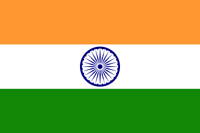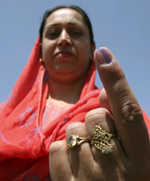India election - history
Key dates in a 60-year history
by Tony Cross
Article published on the 2009-04-17 Latest update 2009-04-30 09:15 TU
The Republic of India (Bharat Ganarajya), which is holding its 15th general election, celebrated its 60th birthday two years ago. Indian civilisation goes back centuries, with the English name derived from the giant Indus river.
Here are some key dates from the modern state's history:
1947: Independence from the British Empire, and partition of the sub-continent into India and, East and West Pakistan, amid violence between Hindus and Muslims, leading to war with Pakistan over Kashmir; Congress leader Jawahar Lal Nehru becomes Prime Minister.
1948: Mahatma Gandhi assassinated by right-wing Hindu nationalist.
1950: New constitution, passed on the 20th anniversary of the Indian National Congress's declaration of independence, declares the Union of India to be a sovereign, democratic republic, assuring its citizens justice, equality and liberty.
1962: Border war with China.
1964: Gulzarilal Nanda (Congress) becomes Prime Minister after Nehru's death, to be followed in the same year by Congress's Lal Bahadur Shastri.
1965: War with Pakistan over Kashmir.
1966:Gulzarilal Nanda (Congress) becomes Prime Minister, to be followed, in the same year by Congress's Indira Gandhi, Nehru's daughter.
1971: Intervention in East Pakistan, in support of the creation of Bangladesh.
1975: Opposition campaign over accusations of vote-fraud leads to declaration State of Emergency in which many of Prime Minister Indira Gandhi's opponents are jailed.
1977: Election leads to Congress losing power for the first time to a coalition, which elects the Janata Party's Moraji Desai as Prime Minister.
1979: Charan Singh splits from Janata to become Prime Minister but the Lok Sabha (lower house of parliament) never meets as a result of Congress withdrawing support for him.
1980: Election brings Indira Gandhi back as Prime Minister.
1984: Indian troops storm the Harmandir Sahib Sikh temple in Amritsar to evict armed supporters of Sikh separatist Jarnail Singh Bhindranwale; 83 soldiers and 492 civilians are officially reported dead, inlcluding Bhindranwale; Indira Gandhi is assassinated in her garden by Sikh bodyguards; Congress stays in power in general election and Indira Gandhi's son, Rajiv, becomes Prime Minister.
1989: General election leads to Janata's VP Singh becoming Prime Minister.
1990: Chandra Shekhar of the socialist Samajwadi Janata Party becomes Prime Minister, thanks to Congress support.
1991: Election; assassination of Rajiv Gandhi by a female suicide bomber - a member of the Liberation Tigers of Tamil Eelam (LTTE) fighting for an independent Tamil homeland in Sri Lanka; PV Narasima Rao, of the Congress Party, becomes Prime Minister.
1996: Hung parliament leads to political crisis, Atal Bihari Vajpayee of the Bharatiya Janata Party (BJP) becomes Prime Minister, followed by HD Deve Gowda of Janata Dal.
1997: Janata Dal's Inder Kumal Gujral becomes Prime Minister.
1998: Election leads to BJP's Atal Bihari Vajpayee becoming Prime Minister.
1999: Kargil War with Pakistan, over Kashmir; Election.
2004: General election, resulting in a coalition government led by Congress; party leader Sonia Gandhi refuses Prime Minister's job which goes to Manmohan Singh.
See also Two decades of bombings and shootings.
India - elections
Voting starts as 16 killed by Maoist attacks, Varun Gandhi freed
2009-04-20 09:18 TU












